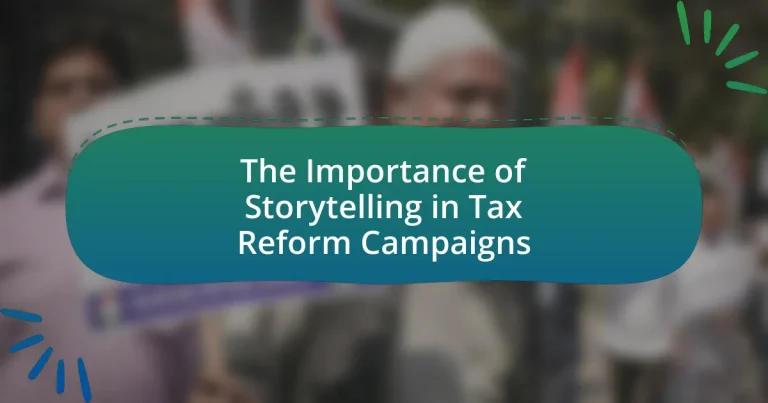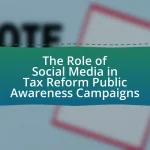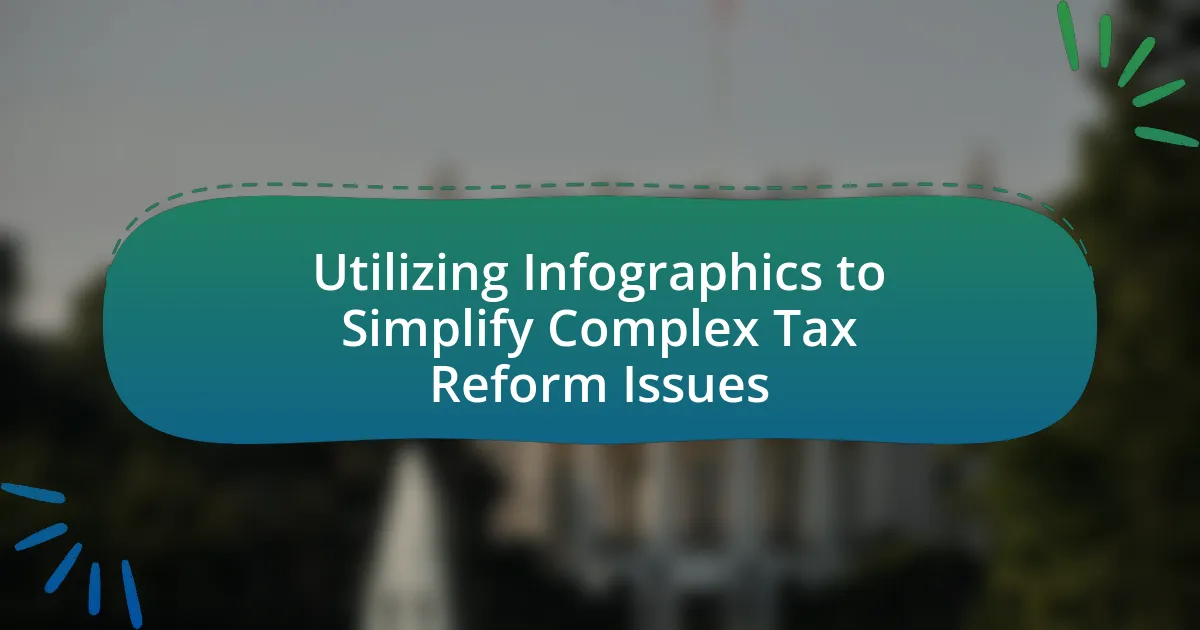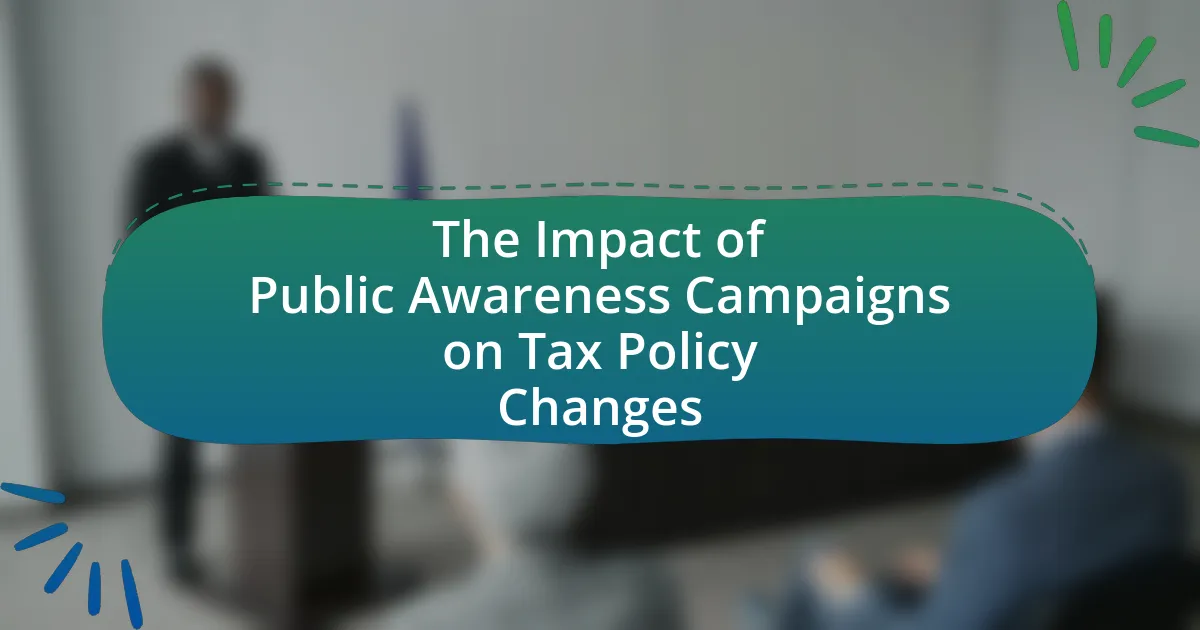The article focuses on the significance of storytelling in tax reform campaigns, emphasizing its role in making complex tax issues relatable and understandable to the public. It highlights how personal narratives and emotional connections can enhance public perception, increase engagement, and drive support for necessary reforms. Key components of effective storytelling, such as clarity, relatability, and emotional appeal, are discussed, along with strategies for integrating data and addressing misconceptions. The article also outlines best practices for crafting authentic stories that resonate with audiences, ultimately demonstrating the power of storytelling as a critical tool for tax reform advocates.

What is the Importance of Storytelling in Tax Reform Campaigns?
Storytelling is crucial in tax reform campaigns because it humanizes complex issues, making them relatable and understandable to the public. By presenting real-life examples and narratives, campaigns can illustrate the tangible impacts of tax policies on individuals and communities, thereby fostering emotional connections. Research indicates that narratives can increase engagement and retention of information; for instance, a study by the Stanford Graduate School of Business found that stories are 22 times more memorable than facts alone. This ability to resonate with voters enhances advocacy efforts, ultimately driving support for necessary reforms.
How does storytelling influence public perception of tax reform?
Storytelling significantly influences public perception of tax reform by framing complex issues in relatable narratives. These narratives help individuals understand the implications of tax policies on their daily lives, making abstract concepts more tangible. For instance, studies show that personal stories about how tax changes affect families or local businesses can evoke emotional responses, leading to increased engagement and support for specific reforms. Research from the Stanford Graduate School of Business indicates that stories can enhance memory retention and persuasion, demonstrating that well-crafted narratives can effectively shape public opinion on tax reform initiatives.
What elements of storytelling resonate most with audiences?
Emotional connection is the primary element of storytelling that resonates most with audiences. When stories evoke feelings such as empathy, joy, or sadness, they create a bond between the storyteller and the audience, making the message more impactful. Research indicates that narratives that include personal experiences or relatable characters significantly enhance emotional engagement, leading to better retention of information and increased persuasion. For instance, a study published in the journal “Psychological Science” found that stories that elicit strong emotional responses can increase the likelihood of behavioral change, demonstrating the effectiveness of emotional storytelling in campaigns, including those focused on tax reform.
How can emotional narratives enhance understanding of tax issues?
Emotional narratives can enhance understanding of tax issues by making complex concepts relatable and engaging for individuals. When tax issues are framed within personal stories, they evoke empathy and allow people to connect emotionally with the implications of tax policies. Research indicates that narratives can significantly influence public perception and understanding; for instance, a study published in the Journal of Communication found that storytelling can improve retention of information by up to 65%. By illustrating real-life consequences of tax decisions through emotional storytelling, individuals are more likely to grasp the significance and impact of tax reforms on their lives and communities.
Why is storytelling a critical tool for tax reform advocates?
Storytelling is a critical tool for tax reform advocates because it effectively humanizes complex issues, making them relatable and understandable to the general public. By sharing personal narratives and real-life examples, advocates can illustrate the tangible impacts of tax policies on individuals and communities, thereby fostering emotional connections that statistics alone cannot achieve. Research indicates that stories can increase engagement and retention of information, which is essential for mobilizing support for reform initiatives. For instance, a study by the FrameWorks Institute found that narratives significantly enhance public understanding of policy issues, leading to greater advocacy and action.
What role does storytelling play in simplifying complex tax concepts?
Storytelling plays a crucial role in simplifying complex tax concepts by transforming abstract ideas into relatable narratives. This approach allows individuals to grasp intricate tax regulations and principles through familiar scenarios, making the information more accessible. For instance, using stories about everyday financial situations can illustrate how tax laws impact personal finances, thereby enhancing understanding. Research indicates that narratives engage the brain more effectively than raw data, leading to better retention and comprehension of complex subjects.
How can personal stories drive engagement and support for tax reform?
Personal stories can drive engagement and support for tax reform by humanizing complex issues and making them relatable to the public. When individuals share their experiences with tax burdens or benefits, it creates an emotional connection that resonates with others, fostering a sense of community and shared purpose. Research indicates that narratives can significantly influence public opinion; for instance, a study by the FrameWorks Institute found that storytelling can increase understanding of policy issues by 60%. This emotional appeal not only raises awareness but also mobilizes individuals to advocate for change, as they see the direct impact of tax reform on real lives.
What are the key components of effective storytelling in tax reform campaigns?
The key components of effective storytelling in tax reform campaigns include clarity, relatability, emotional appeal, and a strong narrative structure. Clarity ensures that the message is easily understood, allowing the audience to grasp complex tax issues without confusion. Relatability connects the audience to the story, often through personal anecdotes or examples that illustrate how tax reform impacts everyday lives. Emotional appeal engages the audience’s feelings, making the story resonate on a deeper level, which can motivate action or support. A strong narrative structure organizes the information logically, guiding the audience through the story in a compelling way. These components are essential for effectively communicating the importance and implications of tax reform to diverse audiences.
What types of stories are most impactful in tax reform messaging?
Personal narratives and case studies are the most impactful types of stories in tax reform messaging. These stories resonate with audiences by illustrating real-life consequences of tax policies on individuals and families, making abstract concepts more relatable. For instance, a case study detailing how a tax reform benefited a small business can effectively demonstrate the positive economic impact, while personal narratives about struggling families can highlight the need for reform. Research shows that emotional engagement through storytelling significantly increases message retention and persuasion, as evidenced by a study from the Stanford Graduate School of Business, which found that stories are 22 times more memorable than facts alone.
How can data and statistics be integrated into storytelling?
Data and statistics can be integrated into storytelling by using them to support narratives and enhance emotional engagement. For instance, presenting compelling statistics about tax reform impacts, such as the percentage of families benefiting from a tax cut, can provide a factual basis that resonates with the audience’s experiences. Research shows that stories combined with data are 22 times more memorable than facts alone, as demonstrated by a study from the Wharton School of Business. This integration allows storytellers to create a more persuasive and relatable message, making complex issues like tax reform more accessible and impactful for the audience.
How can storytelling be used to address common misconceptions about tax reform?
Storytelling can effectively address common misconceptions about tax reform by humanizing complex issues and making them relatable. By sharing personal narratives or case studies, individuals can illustrate how tax reforms impact real lives, thereby clarifying misunderstandings. For instance, a story about a small business owner who benefited from a tax cut can counter the misconception that tax reforms only favor the wealthy. Research shows that narratives can enhance understanding and retention of information, making them a powerful tool in public discourse about tax policy.
What strategies can enhance the effectiveness of storytelling in tax reform campaigns?
Effective storytelling in tax reform campaigns can be enhanced through the use of relatable narratives, data-driven evidence, and emotional engagement. Relatable narratives help the audience connect with the issues at hand, making complex tax concepts more understandable. For instance, personal stories of individuals affected by tax policies can illustrate the real-world impact of reforms. Data-driven evidence, such as statistics on tax burdens or economic benefits, reinforces the narrative and provides credibility. Emotional engagement, achieved through compelling visuals and impactful language, can motivate the audience to support the reform. Research indicates that campaigns utilizing these strategies are more likely to resonate with the public and drive advocacy efforts, as evidenced by successful initiatives in various regions that have employed similar storytelling techniques.
What best practices should be followed when crafting stories for tax reform advocacy?
When crafting stories for tax reform advocacy, it is essential to focus on relatable narratives that highlight the real-life impact of tax policies on individuals and communities. Effective stories should include personal testimonials that illustrate how tax reform can alleviate financial burdens or enhance opportunities, thereby making the issue more tangible for the audience.
Additionally, incorporating data and statistics can strengthen the narrative; for example, citing studies that show how tax reforms have positively affected economic growth or social equity can provide a factual basis for the advocacy. Engaging storytelling should also address common misconceptions about tax reform, using clear language to demystify complex tax issues and foster understanding.
Moreover, aligning the stories with the values and priorities of the target audience can enhance resonance, making it more likely that the audience will support the proposed reforms. By focusing on these best practices, advocates can create compelling narratives that effectively communicate the importance of tax reform.
How can campaigners ensure their stories are relatable and authentic?
Campaigners can ensure their stories are relatable and authentic by incorporating real-life experiences and emotions that resonate with their audience. This approach fosters a connection, as studies show that narratives grounded in personal stories increase engagement and empathy among listeners. For instance, a campaign that shares testimonials from individuals directly affected by tax reforms can illustrate the tangible impact of policies, making the message more relatable. Additionally, using clear, straightforward language and avoiding jargon helps to maintain authenticity, as it allows the audience to easily understand and relate to the message being conveyed.
What methods can be used to measure the impact of storytelling in campaigns?
Methods to measure the impact of storytelling in campaigns include qualitative analysis, quantitative metrics, and audience feedback. Qualitative analysis involves assessing emotional responses through focus groups or interviews, which can reveal how stories resonate with audiences. Quantitative metrics can be tracked using engagement statistics such as shares, likes, and comments on social media platforms, providing measurable data on audience interaction. Audience feedback, gathered through surveys or polls, can directly gauge the effectiveness of storytelling in conveying messages and influencing perceptions. These methods collectively provide a comprehensive understanding of storytelling’s impact in campaigns.




